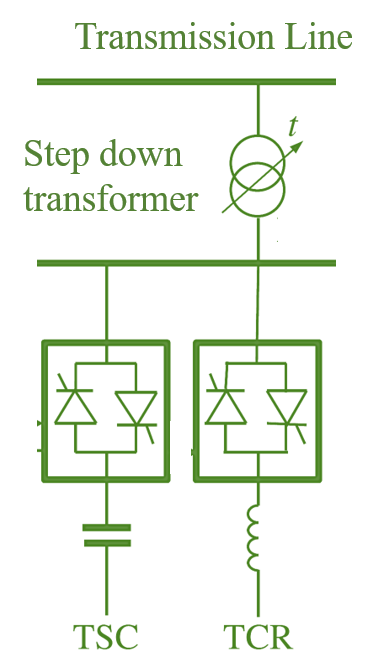In this topic, you study Static VAR Compensator – Definition, Types, Diagram, Advantages, & Applications.
The static VAR compensator (SVC) is a first generation FACTS controllers. It is a variable impedance device in which the current through a reactor is controlled by back to back connected thyristors. These thyristor valves are rated for lower voltages as the SVC is connected to the transmission line through a step down transformer or through the tertiary winding of a power transformer. The location of SVC is important in determining its effectiveness. They should be located at load centre or midpoint of a transmission line.
Types of Static VAR Compensator (SVC)
There are two types of SVC
Fixed Capacitor – Thyristor Controlled Reactor (FC-TCR)
Thyristor Switched Capacitor – Thyristor Controlled Reactor (TSC-TCR)
The second type SVC i.e. TSC-TCR is more flexible, requires smaller reactor and hence generates less harmonics.
Working of Static VAR Compensator (SVC)
Figure 1 shows a static VAR compensator. It is a shunt connected combination which includes a separate thyristor controlled reactor for absorbing reactive power and thyristor switched capacitor for supplying the reactive power. The TCR and TSC are connected on the secondary side of a step down transformer. The TSC is switched in using two thyristors connected back to back at the instant in a cycle when the voltage across valve is minimum and positive. This results in minimum switching transient. The current in a TCR can be continuously varied from zero to maximum by phase control in which the firing angle is varied from 180° to 90°.

Figure 1: Static VAR compensator.
Advantages of Static VAR Compensator (SVC)
- It can control voltage rapidly.
- It can control temporary overvoltage with high speed.
Applications of Static VAR Compensator (SVC)
The use of SVC improves transmission capacity and steady state limit. SVC can be used for stability improvements both during small and large disturbances. Its use can also damp the sub-synchronous oscillations. The cost of a SVC is lesser as compared to a STATCOM.
Disadvantages of Static VAR Compensator (SVC)
- It has limited overload capability.
- More expensive.